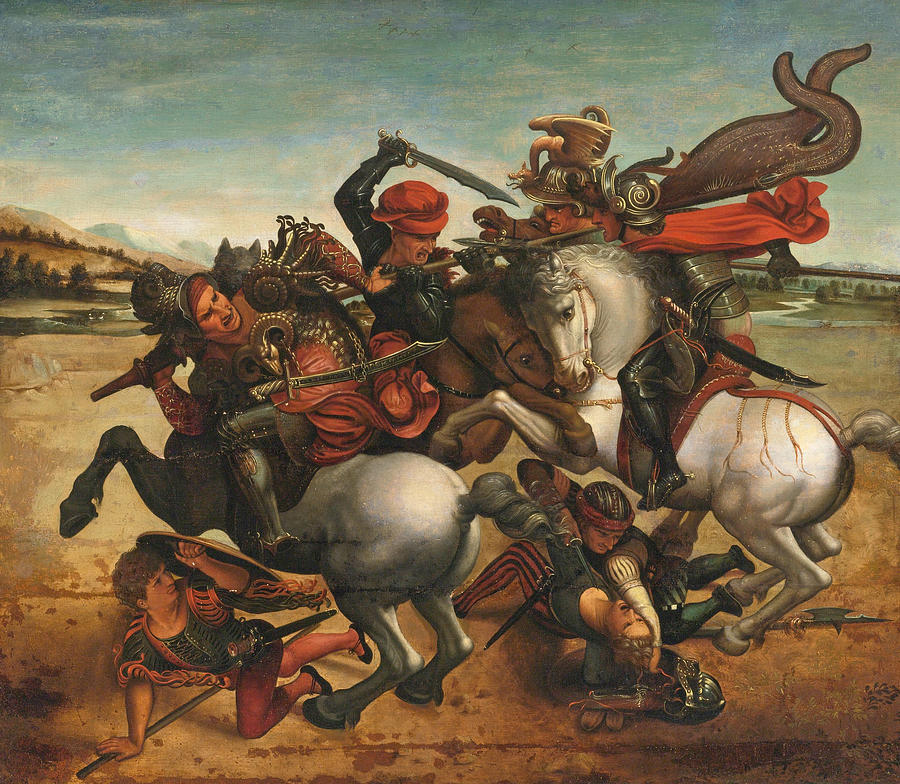
The Fight for the Standard from the Battle of Anghiari Painting by
The artwork chosen for the single-piece edition Les Cabinotier is the La lutte pour l'étendard de la Bataille d'Anghiari, by Pierre Paul Ruben, and 100% of the auction's proceeds benefited Le Studio, a place where visitors can learn more about the Louvre's artwork through the development of art and cultural education.

The Battle of Anghiari Leonardo da Vinci
Schéma de "La bataille d'Anghiari (copie d'un détail)" 1503-5, Degli Uffizi, Florence de Galleria Quatre copies "in situ" de la scène de la lutte pour l'étendard de la bataille d'Anghiari de de Vinci (probablement par P.P. Rubens, Ricellai, un anonyme et Commodo: sources internet non vérifiées) Salle des Cinq Cents.

Leonardo Da Vinci The Battle Of Anghiari Rubens Digital Art by PixBreak Art
The controversy prevails, and studies continue, but for now, we can only admire the copies which circulate of the work. During the Battle of Anghiari in 1440, Florentine armies fought against Milanese armies in the valley at the feet of Anghiari. The Florentines won the battle, commissioning a fresco from Leonardo da Vinci as celebration.

La Bataille d'Anghiari Wikiwand
Bataille d'Anghiari ou combat d'Anghiari peut faire référence à : bataille d'Anghiari, entre les Milanais et les Florentins en 1425 ; bataille d'Anghiari, entre les Milanais et les Florentins le 29 juin 1440 sujet de la peinture disparue de Léonard de Vinci La Bataille d'Anghiari ;

'La lutte pour l'étendard' de la 'Bataille d'Anghiari' Louvre Collections
The Battle of Anghiari was fought on 29 June 1440, between the forces of Milan and the League of some Italian states led by the Republic of Florence in the course of the Wars in Lombardy.The battle was a victory for the Florentines, who secured their domination of central Italy. The battle is well known for its depiction in a failed attempt at a painting by Leonardo da Vinci, now known only by.
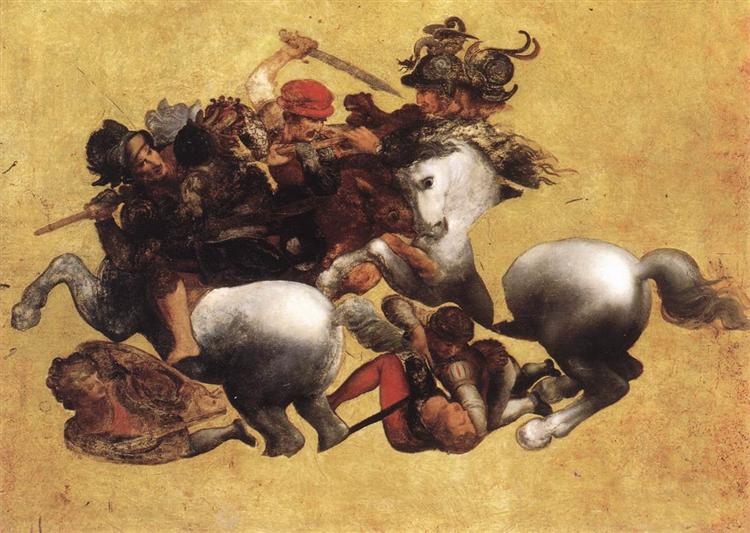
Battle of Anghiari, c.1503 c.1505 Leonardo da Vinci
La Bataille d'Anghiari : un échec technique. En 1503, la République florentine commande à Léonard de Vinci une fresque guerrière pour orner un mur de la salle du conseil du Pallazo Vecchio : la bataille d'Anghiari. Cette scène devait rappeler la victoire des Florentins sur les Milanais le 29 juin 1440 en Toscane. Léonard commence l.
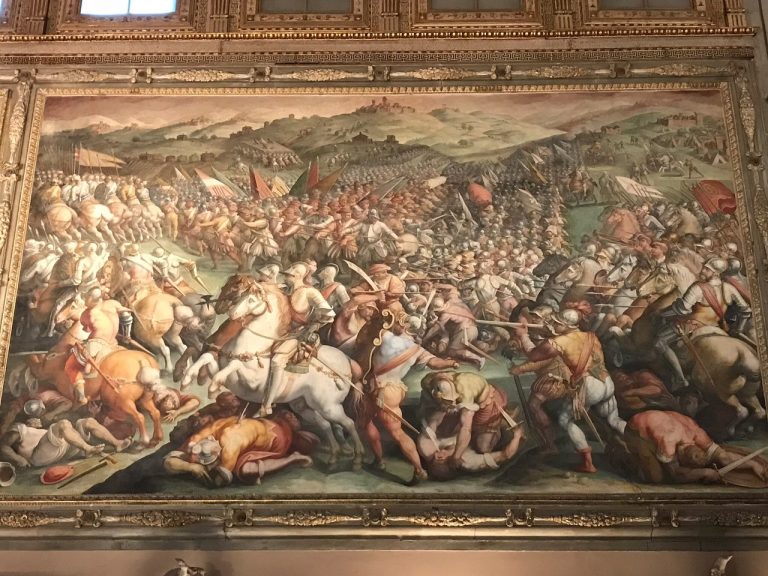
Leonardo non dipinse mai la Battaglia di Anghiari MetroNews
Media in category "Battle of Anghiari" The following 8 files are in this category, out of 8 total. Arca de la Batalla de Anghiari (M.A.N. 51936) 01.jpg 2,537 × 1,986; 1.52 MB. Battle of Anghiari model.jpg 2,444 × 1,598; 491 KB. Artgate Fondazione Cariplo - Courtois Jacques detto il Borgognone, Battaglia.jpg 800 × 547; 106 KB.

La Bataille d'Anghiari Dibujos
This is the Vacheron Constantin Les Cabinotiers Homage to Peter Paul Rubens' La lutte pour l'étendard de la Bataille d'Anghiari. This unique watch started back in December of 2020 when Vacheron Constantin took part in an auction with 100% of the proceeds benefiting Le Studio du Louvre, a studio space that houses the vast project of educational.
.jpg)
The Battle of Anghiari by Leonardo da Vinci
Léonard de Vinci, Étude de deux têtes pour la « Bataille d'Anghiari », 1504-1505. i. Le 24 octobre 1503, Léonard s'attèle au projet sur lequel il planche durant deux ans avec cinq assistants. Ses croquis et cartons préparatoires achevés, il commence à peindre le 6 juin 1505. Les biographes de l'époque rapportent qu'il.

La Bataille d'Anghiari Art du collage, Peinture dessin, Art et
Following the example of Les Cabinotiers - Homage to Pierre Paul Rubens, La lutte pour l'étendard de la Bataille d'Anghiari, a single-piece edition watch from the "Bid for the Louvre" auction in 2020, Vacheron Constantin is now proposing a new experiential offer called "A Masterpiece on the Wrist". It involves creating a single-piece edition.
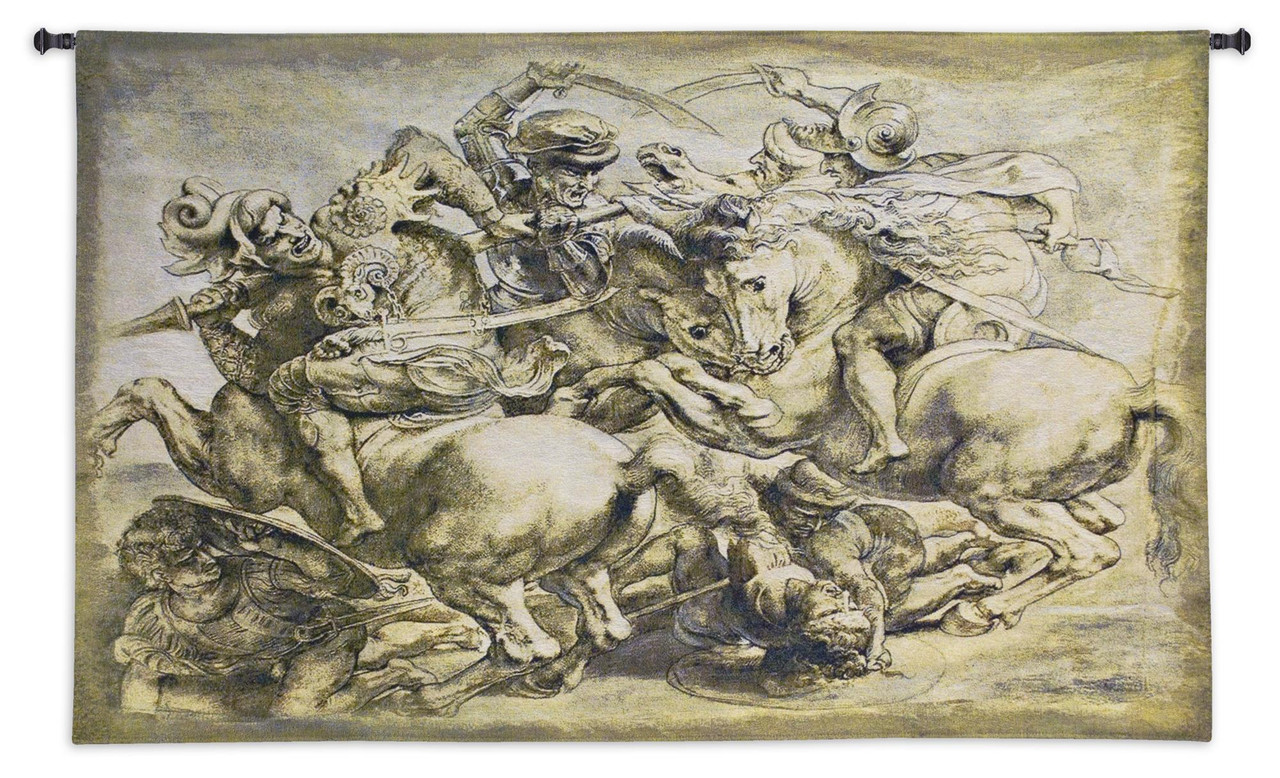
The Battle of Anghiari by Leonardo da Vinci Woven Tapestry Wall Art
Peter Paul Rubens's copy of The Battle of Anghiari.Purportedly, from left to right are Francesco Piccinino; Niccolò Piccinino; Ludovico Trevisan; Giovanni Antonio Del Balzo Orsini.. The Battle of Anghiari (1505) was a planned painting by Leonardo da Vinci in the Salone dei Cinquecento (Hall of the Five Hundred) in the Palazzo Vecchio, Florence.Its central scene would have depicted four men.

ArtStation The Battle of Anghiari " Leonardo da Vinci ", farzad
La lutte pour l'étendard de la Bataille d'Anghiari The drawing by Pierre Paul Rubens has an extraordinary historical background. During his stay in Italy during the early 17th century, the Flemish painter is said to have purchased and then retouched in ink, wash and gouache this sheet depicting the Battle of Anghiari, a vast composition that.

Fresques Alexis Guy Korovine
The bespoke single-piece edition Les Cabinotiers - Homage to Pierre Paul Rubens, La lutte pour l'étendard de la Bataille d'Anghiari watch sold at the 2020 Bid for the Louvre auction combines history with artistic complexity and testifies to the vitality of this partnership.

Cavalier, étude d'après la Bataille d'Anghiari Louvre Collections
The Battle of Anghiari, by Leonardo Da Vinci. The Battle of Anghiari is a lost painting by Leonardo da Vinci at times referred to as, "The Lost Leonardo", which some commentators believe to be still hidden beneath later frescoes in the Hall of Five Hundred (Salone dei Cinquecento) in the Palazzo Vecchio, Florence. Its central scene depicted three men riding raging war horses engaged in a battle.

La bataille d’Anghiari… un chef d’œuvre disparu ? Revue Politique et
On June 29th, 1440, the mercenary commander Niccolo Piccinino attacked the papal troops of Florence at Anghiari. Piccinino lost the battle and the new Republic of Florence chose the victory as a fitting subject for the decoration of their new council chamber in the Palazzo Vecchio. Leonardo secured the contract for the painting in the Autumn of.
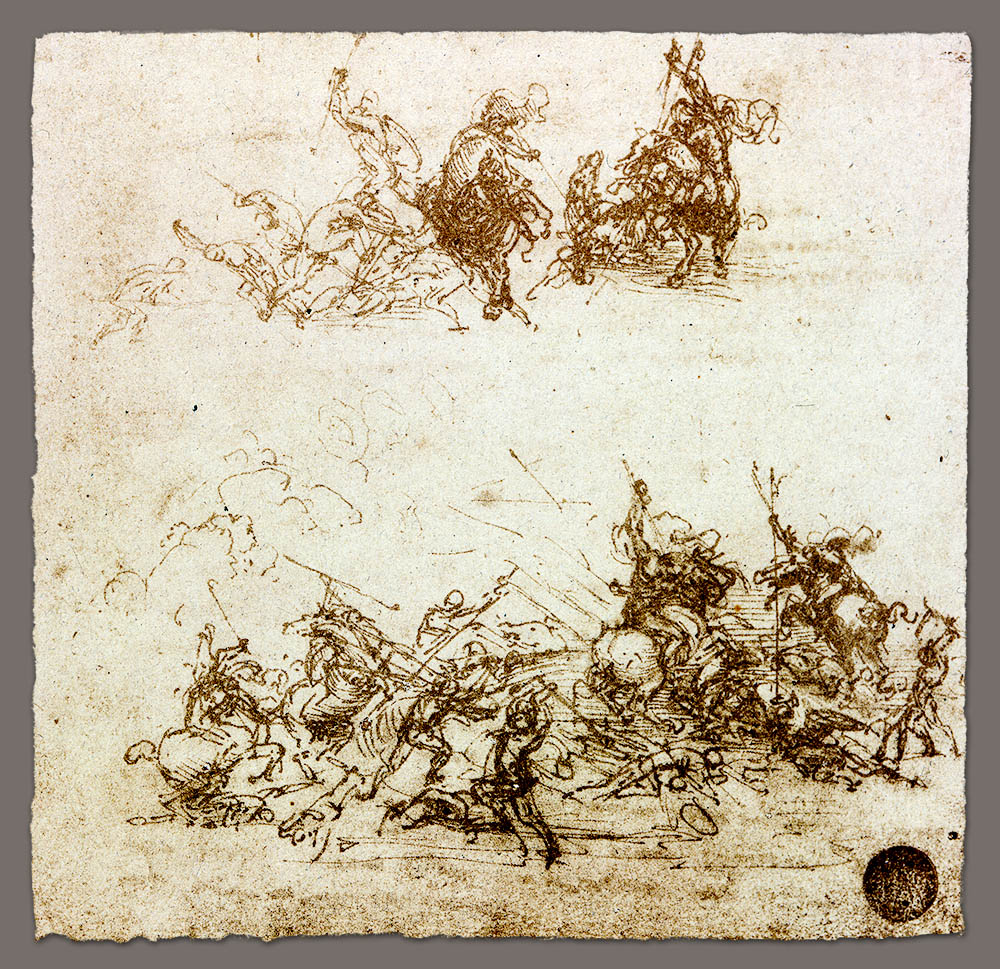
zoom (nouvelle fenêtre)
Anghiari est un petit village niché dans la magnifique campagne toscane, à quelques kilomètres d' Arezzo, dans la Valtiberina Toscana. En raison de sa position stratégique, Anghiari a joué un rôle très important au Moyen Âge. Dans la plaine située juste en dessous du village, le 29 juin 1440, eut lieu la célèbre Bataille d'Anghiari.